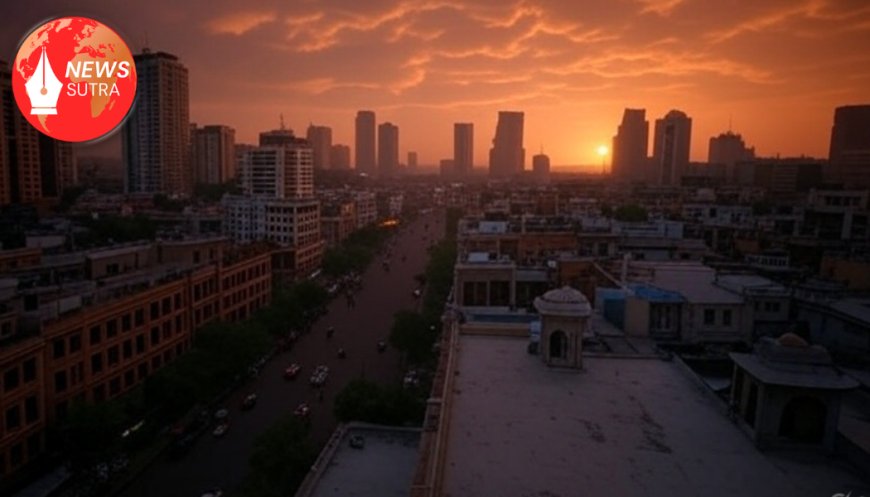Delhi Urban Adda 2025 Outcomes: EV Push, Dust Control & Smart Infrastructure
Discover the major outcomes from Delhi’s Urban Adda Summit—EV policy upgrade, dust-pollution control lab, public transport reforms, Vision Zero road safety, and smart urban infrastructure initiatives.

From June 3 to 5, 2025, Delhi hosted an influential forum at the India Habitat Centre — Urban Adda 2025. Organised by the Raahgiri Foundation with the International Council on Clean Transportation (ICCT) and GuruJal, the summit coincided with World Bicycle Day and World Environment Day. It featured over 30 sessions, 100+ speakers, and over 600 participants, including policymakers, civic leaders, and transport experts urbanvoices.in+7newsmantra.in+7hindustantimes.com+7. The diverse agenda focused on clean mobility, urban dust control, cycling, smart governance and inclusive city design.
1. Electric Vehicle (EV) Policy 2.0: Revolutionizing Urban Mobility
Announcement: EV Policy 2.0 Launching Soon
At the summit, Delhi Transport Minister Pankaj Kumar Singh announced that the EV Policy 2.0 would be introduced “by next month,” pending cabinet approval timesofindia.indiatimes.comnewsmantra.in+3business-standard.com+3outlookbusiness.com+3. The updated policy emphasizes:
-
Deployment of 2,300 e-autos near metro stations as part of the new Air Pollution Mitigation Plan 2025 business-standard.com.
-
Expansion of charging infrastructure, including 40 EV depots currently under construction .
-
Technological integration in DTC buses—CCTV, GPS, UPI-based fares, and route rationalisation to reach newly developed urban zones hindustantimes.com+1outlookbusiness.com+1.
Minister Singh also revealed plans to continually augment the Delhi Transport Corporation (DTC) fleet with hundreds of EV buses, aiming to eliminate older models and ensure last-mile connectivity outlookbusiness.com+1hindustantimes.com+1.
2. ‘War on Pollution’: EVs, Enforcement & Economic Stakes
Expert Consensus
At the plenary, ICCT and IIT Roorkee unveiled a comprehensive review of Indian lifecycle assessments, confirming battery-electric vehicles (BEVs) as the optimal solution for lowering emissions in urban areas newsmantra.in.
-
ICCT India Managing Director Amit Bhatt emphasized: “Avoiding combustion in cities must become a basic planning principle.” Policies must act swiftly to phase out fossil-fuel vehicles newsmantra.in.
-
CAQM Chair Rajesh Verma cited a startling statistic: vehicle volume in Delhi–NCR has increased 21‑fold since 1981, while road space has only doubled newsmantra.in.
-
G20 Sherpa Amitabh Kant quantified the stakes: Delhi spends approximately ₹100,000 cr and loses ~6.3 years of life expectancy per citizen annually due to air pollution newsmantra.in.
Their call to action included:
-
Rapid electrification of 2&3‑wheeler and taxi fleets within 12–24 months.
-
Mandating electric or retrofitted school buses.
-
Requiring brick kilns to adopt Zigzag technology.
-
Installing Flue Gas Desulphurization (FGD) and Dry Sorbent Injection (DSI) in thermal power plants newsmantra.in.
3. Dust Mitigation through the ‘Resources Lab’
To combat Delhi’s chronic dust pollution, the Commission for Air Quality Management (CAQM) and Raahgiri Foundation signed a Memorandum of Understanding to establish a Resources Lab hindustantimes.com+6newsmantra.in+6timesofindia.indiatimes.com+6. Based on the Janpath model in Gurugram, this initiative will:
-
Train officials and civic staff on sustainable road design, dust suppression, PM measurement, and non‑motorised transport infrastructure.
-
Pilot replicable models aimed at reducing particulate pollution across the Delhi–NCR region.
4. Vision Zero & Inclusive Urban Design
Urban Adda reaffirmed its commitment to Vision Zero, a global initiative aimed at eliminating traffic deaths and serious injuries outlookbusiness.com+7newsmantra.in+7timesofindia.indiatimes.com+7business-standard.com+7hindustantimes.com+7timesofindia.indiatimes.com+7.
-
Professor Geetam Tiwari (IIT Delhi) highlighted that speeds above 30 km/h cause 85% of serious urban traffic injuries. She advocated lower speeds in school zones and redesigned road geometry to physically enforce safety hindustantimes.com+1timesofindia.indiatimes.com+1.
-
Gurgaon traffic police will begin recognizing compliant drivers as “traffic warriors,” leveraging intelligent matrix-based cameras timesofindia.indiatimes.com.
-
A demonstration involving participants using wheelchairs and blindfolds underscored infrastructure challenges for persons with disabilities hindustantimes.com+1timesofindia.indiatimes.com+1. Stuti Kacker, former Secretary of the Social Justice Ministry, argued we still lag on inclusive design despite progress hindustantimes.com+1timesofindia.indiatimes.com+1.
-
Delhi Metro reaffirmed accessible measures such as tactile guidance, audio announcements, and high involvement of station staff—foregrounding usability for all citizens timesofindia.indiatimes.com.
5. Bus Infrastructure Retrofit & Governance Promotion
Transport Minister Singh also unveiled a busy timeline for modernising bus shelters:
-
All bus queue shelters will be upgraded within 100 days to include shaded areas, seating, and drinking water as part of a broader Unified Metropolitan Transport Authority and Urban Transport Fund framework hindustantimes.com.
-
He also raised the prospect of legal mechanisms to target traffic violators, emphasising data-driven governance.
6. Smart Infrastructure: Data, Equity and Urban Resilience
Urban Adda spotlighted broader smart infrastructure themes:
-
Integration of CCTV, GPS, UPI-based ticketing and ANPR cameras on pollution-prone routes outlookbusiness.comtimesofindia.indiatimes.comhindustantimes.com.
-
Discussions on water-security tools, urban ecology modelling, public transport governance and last-mile connectivity by Dr. Hanif Qureshi (MoHI), including the goal of 50,000 e-buses by 2050 under the National e-Bus programme newsmantra.in.
-
Urban water security emerged in technical sessions, while workshops encouraged gender equity and human-centric city design .
Why These Outcomes Matter
-
Policy Momentum: The EV Policy 2.0 and Air Plan signal a systemic pivot toward zero-emission transport — not incremental tweaks.
-
Public Health Impact: EVs and dust control address both vehicular emissions and fugitive particulates—two primary contributors to Delhi’s toxic air.
-
Economic & Social Benefits: Cleaner air could extend life expectancy while reducing healthcare costs—a boon worth ₹100,000 cr annually .
-
Safe, Inclusive Cities: Vision Zero and ADA-compliant infrastructure demonstrate a commitment to vulnerable road users and those with disabilities.
-
Smart Governance: Data integration, enforcement tools and expert capacity-building labs reflect Delhi’s nascent shift to citizen‑centric urban management.
Conclusion
Urban Adda 2025 marks a decisive shift toward sustainability, safety and smart urban governance in Delhi. From EV Policy 2.0 and public transport overhauls, to evidence-based dust control labs and inclusive infrastructure design—the summit sets a bold, actionable agenda.
Stakeholder momentum is clear, yet long-term success depends on swift implementation, enforcement, and public engagement. Watch for updates on EV deployment, AQI improvements, and infrastructure rollouts in coming months.














